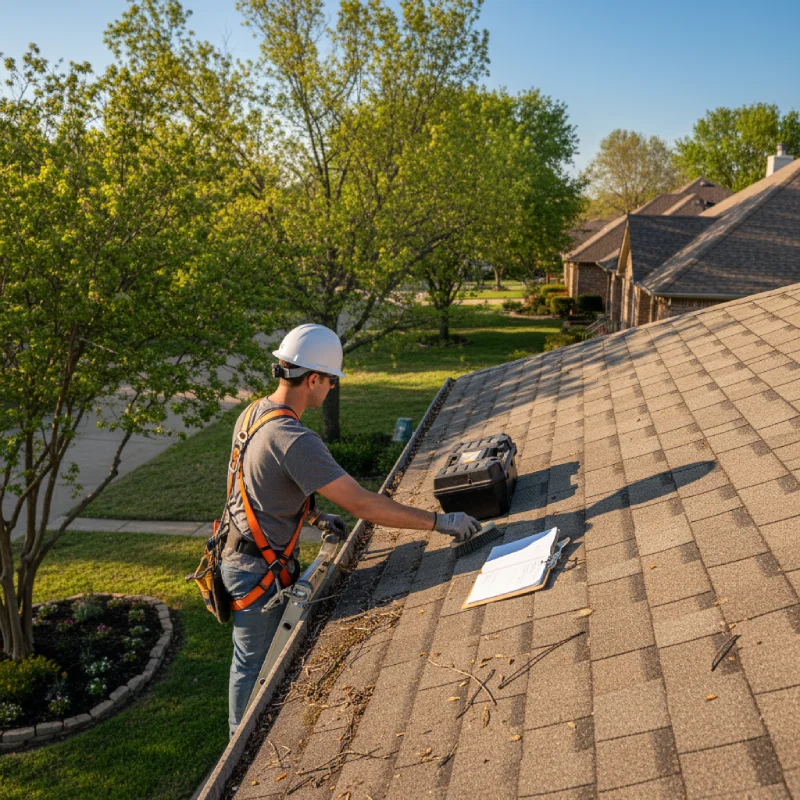
Seasonal roof maintenance in North Texas requires year-round vigilance addressing spring storm damage, summer heat stress, fall preparation, and winter weatherproofing to protect against the region's unique weather challenges and extend roof lifespan.
Your roof stands between your family and North Texas's unpredictable weather—scorching summers, violent spring storms, and occasional winter freezes. Without regular seasonal maintenance, small issues quickly escalate into expensive repairs or premature replacement.
Understanding what to check each season helps you catch problems early, protect your investment, and avoid the headache of emergency repairs during the worst possible moments.
Spring storms in North Texas unleash a powerful combination of hail, high winds, and torrential rain that can devastate residential roofs within minutes. Homeowners should conduct visual inspections from ground level within 24 hours, documenting missing shingles, damaged flashing, and compromised gutters with photographs for insurance claims.
Professional inspectors identify hidden storm damage like shingle bruising and micro-cracks that untrained eyes miss. According to U.S. Department of Energy guidelines, proper attic ventilation is essential to prevent moisture buildup that compounds storm damage effects.
Effective repair priorities include:
While spring storms pose immediate threats, summer's relentless heat creates destructive challenges that unfold gradually over months of scorching temperatures. Regular roof inspections become critical during summer months, focusing on shingles that show curling, blistering, or granule loss from constant UV radiation.
Heat stress particularly affects south- and west-facing slopes, which endure the most intense sunlight throughout the day. Homeowners should monitor attic temperatures, ensuring they remain within 10-15°F of outside temperatures to prevent overheating damage.
Proper ventilation proves essential, requiring clear airflow through vents and soffit openings. Dark granules accumulating in gutters signal advanced deterioration, while brittle or warped shingles become increasingly vulnerable to wind damage after prolonged sun exposure.
Most North Texas homeowners underestimate how essential fall maintenance becomes for protecting roofs against winter's unpredictable patterns. Professional inspections before peak storm season detect early problems while repairs remain manageable.
Homeowners should examine shingles for cracks, curling, or storm damage from summer's intense heat and inspect flashing around chimneys and vents for gaps. Comprehensive storm preparedness includes clearing gutters of leaves and debris, flushing systems to ensure proper drainage, and installing gutter guards.
Fall maintenance checklist:
North Texas winters bring unique challenges that demand proactive weatherproofing strategies, particularly for preventing ice dams that can cause substantial water damage. Proper preparation requires attention to three critical systems that work together to maintain roof integrity throughout the season.
Key winterization areas:
Snow accumulation over six inches can create dangerous structural strain on roofing systems and requires immediate attention. These preventive measures significantly reduce ice dam formation and protect against winter roof damage.
Severe weather events across North Texas demand immediate professional assessment to uncover hidden damage that could compromise structural integrity. Professional contractors employ comprehensive multi-point inspection systems to evaluate critical components including shingles, flashing, roof decking, gutters, and attic spaces.
These certified experts understand local storm damage patterns specific to North Texas weather conditions, detecting subtle issues like granule loss, wind lift, and hail impacts that untrained eyes often miss. Modern inspection methods incorporate drone technology and detailed photographic documentation, providing homeowners with thorough reports for insurance claims.
Effective gutter and drainage maintenance requires consistent attention throughout the year, with debris removal serving as the foundation of any comprehensive care routine. Homeowners must prioritize regular cleaning schedules that adapt to seasonal challenges.
Clogged gutters can hold substantial water weight, causing severe structural damage. Regular cleaning twice yearly—with quarterly maintenance for tree-surrounded homes—prevents overflow that damages siding, foundations, and landscaping.
Proper water direction extends beyond basic cleaning. Downspouts must extend at least five feet from the foundation, utilizing splash blocks or drainage solutions to prevent water accumulation. Professional maintenance includes clearing yard drains, verifying proper terrain grading, and monitoring for standing water that indicates system failure.
A well-functioning attic ventilation system serves as the backbone of roof longevity, requiring homeowners to evaluate airflow patterns and identify potential blockages. Regular assessment ensures hot air escapes efficiently through ridge vents while cool air enters through soffit vents.
North Texas's extreme heat makes effective ventilation solutions essential for preventing damage and maintaining reasonable energy consumption. Homeowners should verify that intake vents in soffits remain unblocked while exhaust vents at ridge lines function properly.
During insulation evaluation, measure existing depth and identify types to calculate current R-value effectiveness. Check whether insulation has been displaced by wiring, plumbing, or HVAC components, creating problematic thermal bridges. Look for moisture damage or pest infiltration that degrades material performance.
Texas homeowners must consider their roofing material's ability to withstand the state's unique climate challenges. The extreme heat, frequent hail storms, and high winds demand specific material performance standards that directly impact maintenance schedules.
| Rating Class | Hail Size Resistance |
| Class 2 | 1.25-inch diameter |
| Class 3 | 1.75-inch diameter |
| Class 4 | 2-inch diameter |
The UL 2218 classification system rates materials from Class 1 to Class 4, with Class 4 providing maximum protection. Investing in Class 4 rated materials reduces long-term maintenance expenses while qualifying homeowners for insurance discounts.
Wind uplift requirements establish critical standards that protect homes during severe weather events. The Texas Department of Insurance enforces stringent guidelines requiring roofing systems to meet specific wind uplift ratings, typically FM 1-90 or UL 580 Class 90 classifications.
Conduct visual inspections twice yearly—in spring and fall—and within 24 hours after any severe storm. North Texas weather demands more frequent monitoring than many regions due to extreme temperature swings, hail frequency, and wind events that can cause rapid deterioration.
Ground-level visual inspections and gutter cleaning are safe DIY tasks. However, professional roofers should handle all work requiring roof access, structural repairs, and post-storm damage assessment. They have proper safety equipment, training, and insurance coverage to protect both you and your home.
Contact a professional immediately if you notice missing or damaged shingles, water stains on ceilings or walls, sagging roof areas, granules accumulating in gutters, daylight visible through the roof boards, or increased energy bills indicating ventilation problems.
North Texas experiences extreme heat causing thermal expansion, frequent hail causing impact damage, high winds creating uplift pressure, and occasional ice causing dam formation. This combination of stressors means roofs here typically require more frequent maintenance than moderate climate regions.
While all seasonal tasks matter, fall gutter cleaning and inspection prove most critical. Clean gutters before winter prevent ice dams and water backup, while pre-winter inspections identify issues before they worsen during freeze-thaw cycles. This preparation protects against the cascading problems that create the most expensive repairs.
Regular seasonal roof maintenance protects North Texas homes from extreme weather conditions while significantly extending roof lifespan. Homeowners who follow comprehensive checklists for spring storm assessment, summer heat monitoring, fall preparation, and winter weatherproofing avoid unexpected repair expenses and ensure their investment remains protected.
Professional inspections after severe weather guarantee hidden damage receives prompt attention before minor issues become major problems. Consistent maintenance schedules combined with proper material selection safeguard your most important investment through every season.
Protect your North Texas home year-round. Schedule your seasonal roof inspection with experienced local professionals who understand our unique weather challenges and building requirements. Don't wait for visible damage—proactive maintenance saves you time, stress, and substantial expense down the road.

Whether you’re remodeling a home, expanding a business, or starting from the ground up, TriStar Built is here to guide you every step of the way. With a focus on craftsmanship, communication, and results that last, we make the construction process clear, smooth, and worth every investment.

LOCATION: 2126 James Street, Denton, TX 76205
PHONE: (940) 381-2222
© 2025 TRISTAR BUILT - ALL RIGHTS RESERVED | WEB DESIGN & SEO BY: Authority Solutions®